Excerpts from Jim Conrad's
Naturalist Newsletter
from the August 31, 2014 Newsletter issued from the Frio Canyon Nature Education Center in the valley of the Dry Frio River in northern Uvalde County, southwestern Texas, on the southern border of the Edwards Plateau; elevation ~1750m (~5750 ft); N29.62°, W99.86°; USA
HALL'S PANICUM
If you're looking for rare or unusual plants, one good strategy is to visit extreme habitats -- places uncommonly dry, wet, exposed to sun and wind, thin soil atop rocks, etc. Therefore, I wasn't surprised when in the very thin, rocky soil atop the hard layer of Edwards Limestone capping the hill on which Juniper House sits, a grass turned up I hadn't noticed on the slopes and in the Dry Frio Valley below. The foot-tall grass called attention to itself with its very curly, slender leaves, as seen below:
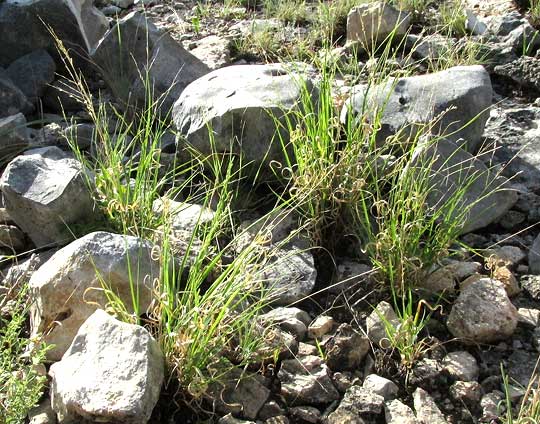
Its flower clusters, or inflorescences, consisted of small spikelets on short, slender stems, or pedicels, which arose from branches of branches off the infloresence's main stem, or rachis -- so that it was a panicle-type inflorescence -- as seen below:
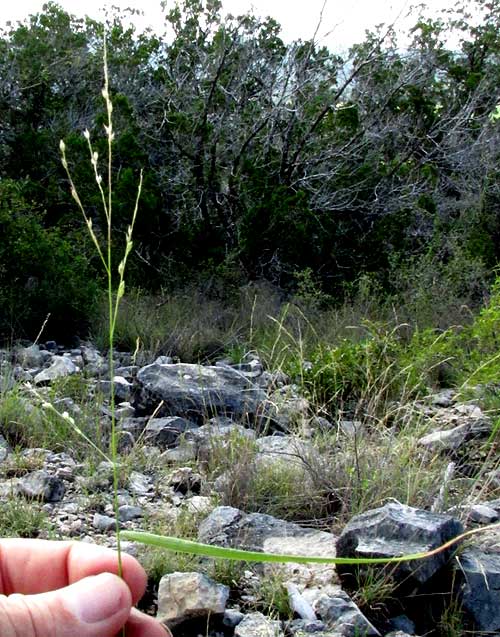
Below, up closer, you can better see the slender pedicels and the spikelets' conspicuously several-ribbed glume:
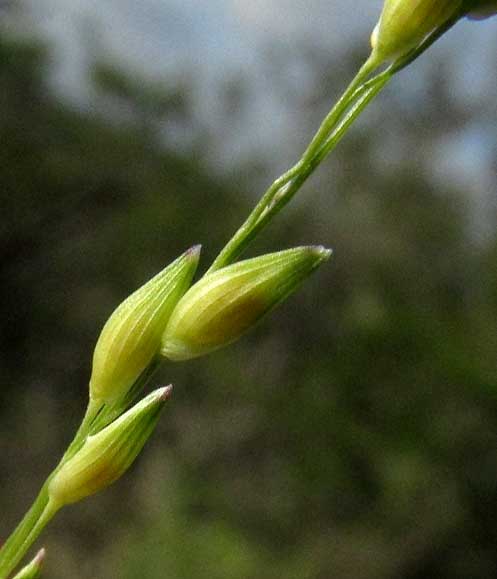
The spikelets on our plant were maturing and falling off. Some are shown below:
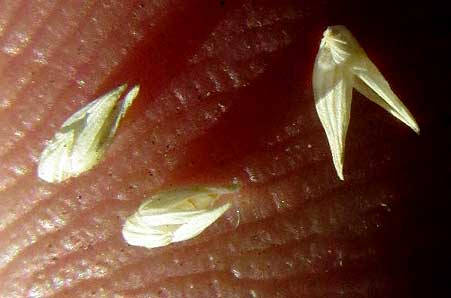
Some grass types drop naked caryopsis-type fruits (dry, one-seeded, not splitting at maturity) but you can see that in this species the caryopses fall mostly enclosed with scales, or glumes. Moreover, the typical grass spikelet consists of two conspicuous glumes, but these appear to bear three. From past experience with this genus, we know that the lower, shorter scale is actually what remains of a sterile, much-reduced second spikelet. Still, that "third glume" is an important field mark.
These traits -- the panicle-type inflorescence, the one-flowered spikelets and the spikelets appearing to be subtended by three instead of two glumes -- point us to the big grass genus Panicum. With about 450 species, of which many are widely spread and commonly occurring, Panicum is a genus worth knowing. Species of Panicum often are referred to as panic grasses.
A large portion of Panicum species produce two leaf-types. At those plants' bases there'll be rosettes of short, broad leaves, typically produced the previous season. The main stem will arise from this rosette bearing longer, more slender leaves, and a panicle of flowering spikelets. Our hilltop Panicum however, produces no rosettes and there's only one leaf type, so that helps a lot in its identification.
Also, many Panicums are annuals, but with such dense tufts of curling leaves, it's easy to see that this species is a perennial, which also narrows down the possibilities considerably. However, when keying out this species, the clincher is what you see below:
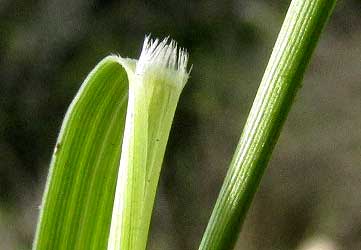
The white fringe of hairs is the ligule, a feature that may or may not exist at the base of a grass's leaf where it meets with the stem. Ligules can be hairy like this one, membranous or stiffly papery, and they can be long or short, shredded, cut down the middle -- all kinds of ways. Panicums in general produce hairy ligules of this type, but the combination of a substantial ligule like this, with the rest of the leaf, including the cylindrical sheath below the ligule, being hairless, is noteworthy.
These and other features identify our grass as the Hall's Panicum, PANICUM HALLII, distributed in the US southwestern states from eastern Texas north to Colorado and southern Utah, west to Arizona, and most of arid northern Mexico.
Hall's Panicum is regarded as only a fair grass for grazing livestock, but lately science has paid attention to it because it is closely related to Switchgrass, Panicum virgatum, which shows possibilities for being grown in mass culture as a source of biofuels. Also, Hall's Panicum has genes easy to work with. One research paper praises Hall's Panicum as a good plant to work with because it "... has the advantages of a tractable diploid genome, a manageable stature, self-fertility, a short life-cycle, and genomic sequence resources from DOE JGI." The words "genomic sequence resources" refer to the fact that Hall's Panicum has had its entire genome sequenced.
Beyond all that, Hall's Panicum is a worthy species if only because it grows in very dry, high-carbonate soil, protecting what little soil is there, and, with its curly leaves, it's a species easy to recognize, once you've been introduced to it.